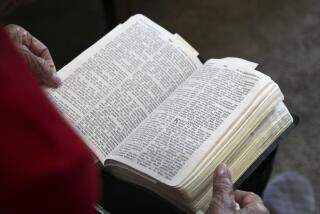And the Authors Said Let There Be Light
- Share via
“Don’t expect anything particularly deep or fancy,” advise the authors of “The Complete Idiot’s Guide to the Bible” (Alpha Books, $16.95). No disappointments there. But if you’ve never giggled your way from Genesis to Revelation, this could be the translation for you. Laughing while you’re learning is not the worst thing. Especially once it’s clear that authors James Bell and Stan Campbell are actually two smart guys. (Bell was director of religious publishing at Doubleday; Campbell works in Christian book publishing.)
Chapter headings give some hint of the tone of the book. To cover a section filled with many tales of woe, ending with the trials of Job, who loses family, possessions and physical health for no apparent reason, there is: “Making the Best of a Bad Situation.”
The letters of Paul come under the catchy “You’ve Got Mail.”
Daredevils who start with the Bible IQ test at the front of the book will feel encouraged. Relax, it’s multiple choice.
Question: Which of the following are not books of the Bible?
Answer: Guacamole and Minestrone. (Could you possibly have missed that?)
A brief history of how the Bible was made is worth clipping for your wallet. It never hurts to appear well-read. In the space of half a page we learn there were about 40 writers of the Bible, and that handwritten copies were handed down through the generations until the 15th century invention of the printing press. Writers of the Hebrew Bible, called the Old Testament by Christians, lived from 1400 to 400 B.C.E. The New Testament was written between 50 and 90 C.E. (Note the newfangled abbreviations. They’re explained in one of the “Manna from Heaven” infographics sprinkled through the book. “Before the Common Era” is used by many Scripture scholars to reflect religious diversity. In contrast, the more traditional BC stands for “Before Christ.” “Common Era” is an alternative to AD, for the Latin anno domini, Year of the Lord.)
Early in the book, a chapter prepares readers for some challenging realities about the world they enter. Customs and values were different in ancient times. Among them, the authors include “the cultural problem” (gender inequality, legalized slavery, for example), “the religion problem” (freedom of religion didn’t exist back then) and “the language problem” (what one person reads as literal another sees as figurative). All the more reason, they argue, to read the Bible for yourself, not let somebody else tell you what the book says.
Helpful maps show the Near East during various political changes through history. Mini-biographies help keep the people straight. Rehoboam, Abijah, Jehoshaphat were kings. Joel, Amos, Micah were prophets. The full list of both is included, with dates and major contributions.
Late-night insomniacs might try guessing which stories go with which headline puns: “Jesus Heals a Ceiling Fan” (in the Gospel of Mark, friends of a paralytic lower him through the roof of the house where Jesus is preaching, and Jesus heals him) and “Splish Splash I Was Taking a Bath” (in the second Book of Samuel, King David falls in love with a woman he sees while she is bathing. She turns out to be Bathsheba. He marries her, once he’s had her husband killed.).
Are you awake?
*
For More Reviews, See Sunday Book Review: This week, “Let’s Go, France”: Sunil Khilnani on the idea of France, Eugen Weber on the French Enlightenment and Flora Lewis on the European century.
More to Read
Sign up for our Book Club newsletter
Get the latest news, events and more from the Los Angeles Times Book Club, and help us get L.A. reading and talking.
You may occasionally receive promotional content from the Los Angeles Times.




